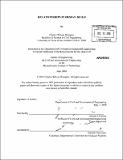| dc.contributor.advisor | Jerome J. Connor. | en_US |
| dc.contributor.author | Wampler, Charles Wilson | en_US |
| dc.contributor.other | Massachusetts Institute of Technology. Dept. of Civil and Environmental Engineering. | en_US |
| dc.date.accessioned | 2011-01-26T14:23:59Z | |
| dc.date.available | 2011-01-26T14:23:59Z | |
| dc.date.copyright | 2010 | en_US |
| dc.date.issued | 2010 | en_US |
| dc.identifier.uri | http://hdl.handle.net/1721.1/60785 | |
| dc.description | Thesis (M. Eng.)--Massachusetts Institute of Technology, Dept. of Civil and Environmental Engineering, 2010. | en_US |
| dc.description | Cataloged from PDF version of thesis. | en_US |
| dc.description | Includes bibliographical references (p. 42-43). | en_US |
| dc.description.abstract | As design build (DB) becomes more popular, different ways of writing contracts and forming relationships with the various parties are being considered. The main point of this paper is to look at the relationships between the various parties involved in the design build delivery method. Contracts are what legally tie the parties together, but there can be many different problems with these contracts. A poor contract can easily strain good working relations. Contracts will divide the responsibility among the contractor and the designer. There are many different ways to mitigate risk for the design build team in a contract. This paper considers several ways to improve the working relations in a design build team. The contractors and designers face a considerable problem when placing a bid for a DB project. Their team could potentially lose a great deal of money if they under bid the project and win. But they risk not winning a project if their bid is high even if it is reasonable. Communication between the owners, contractors, and designers needs to be effective. There are various problems that have been stated by owners that they believe limit design build. The use of a third party has been popular by public project owners to ensure quality and to check the design build team's work. This relationship with third parties needs to be changed so that the project will not be slowed down. There are a few different ways that are discussed to improve the relations between the contractors, designers, and owners and ways to improve many of mentioned problems. | en_US |
| dc.description.statementofresponsibility | by Charles Wilson Wampler. | en_US |
| dc.format.extent | 43 p. | en_US |
| dc.language.iso | eng | en_US |
| dc.publisher | Massachusetts Institute of Technology | en_US |
| dc.rights | M.I.T. theses are protected by
copyright. They may be viewed from this source for any purpose, but
reproduction or distribution in any format is prohibited without written
permission. See provided URL for inquiries about permission. | en_US |
| dc.rights.uri | http://dspace.mit.edu/handle/1721.1/7582 | en_US |
| dc.subject | Civil and Environmental Engineering. | en_US |
| dc.title | Relationships in design build | en_US |
| dc.title.alternative | Relationships in DB | en_US |
| dc.type | Thesis | en_US |
| dc.description.degree | M.Eng. | en_US |
| dc.contributor.department | Massachusetts Institute of Technology. Department of Civil and Environmental Engineering | |
| dc.identifier.oclc | 695396184 | en_US |
